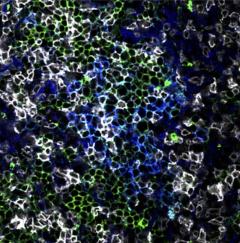Lung tissue forms immune cell hubs when needed
Research uncovers how lung tissue is remodelled to support an immune response to influenza.

A team of researchers have discovered how lung tissue in mice is remodelled to support an immune system response to infection by influenza.
This remodelling facilitates the production of antibodies with the ability to provide protection against a wider range of related viruses.
Protection against different influenza strains
These transient microenvironments, called germinal centres, are vital for effective immune responses and for our immune ‘memory’, which provides protection against subsequent infections.
The researchers found that germinal centre formation in the lungs is initiated via a cascade of events, whereby a chemical message (type I interferon), produced by lung cells in response to infection, triggers the production of a chemical attractant – a ‘come here’ flag to the immune system.
In response to this signal, B cells – the immune cells that produce antibodies – are recruited to the lungs and initiate the formation of germinal centres. These lung-based germinal centres produce a different repertoire of B cells, which produce more broadly reactive antibodies providing cross-protection against different influenza virus strains.
Compounds that stimulate a type I interferon response may be useful as vaccine additions to drive cross-protective antibody production in the lungs.
In the same way that crisis centres are created on the ground in the midst of a humanitarian effort, the immune system can commandeer non-immune-related tissues to create something that resembles an immune cell hub where white blood cells collaborate to generate a co-ordinated response to an invading pathogen.
Being able to exploit this would be extremely beneficial in the case of the annual influenza vaccination where the vaccination is developed against the likely prevalent strain. In the case of vaccinating against one type of influenza virus, wider protection against other types of influenza strains would reduce infections.
Immune responses to other diseases
The research findings are also relevant to our understanding of the immune responses that occur in other inflammatory disorders such as autoimmune disease, chronic obstructive pulmonary disease and cancer.
Further research is now needed to determine whether certain cancers and autoimmune diseases may trigger similar kinds of responses. These results may help to understand those diseases better and inform new therapeutic strategies.
This research has been led by Dr. Michelle Linterman at the Babraham Institute, and The Roslin Institute was one of the partners involved. The work has been funded by the UK’s Biotechnology and Biological Sciences Research Council and is published in the Journal of Experimental Medicine.
*** This news story has been prepared from materials provided by the Babraham Institute. ***


